Feb. 28, 2012
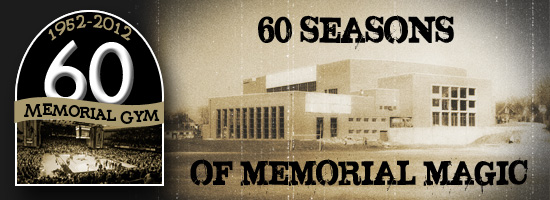
This is the 60th season of basketball in Memorial Gymnasium. To commemorate the occasion, VUCommodores.com will commit the next five days to recall 60 of the most memorable moments from men’s and women’s basketball games played on Vanderbilt’s home court. Each day, VUCommodores.com will reveal 12 historical moments, totaling 60 by Friday. The moments will not be listed by rank.
Submit Your Memorable Moments | Recalling 60 Seasons at Memorial Gym
| 13) | March 14, 1954 | State Championship: West High School beats LaFollette High School, 42-40 |
 1954 Championship Game Footage |
1954 Championship Game Footage |  All the Way for Doc |
All the Way for Doc |  Trophy Presentation
Trophy Presentation
The same year tiny Milan High School defeated powerful Muncie Central to claim an unthinkable state title in Indiana, Tennessee had its own memorable state championship game played at Memorial Gym.
The 42-40 come-from-behind-victory by West High School over LaFollette in 1954 did not spawn a multi-million dollar movie like Milan’s state title did with the movie Hoosiers, but it had all the storylines of a cinematic thriller.
Throughout the entire season, the motto of West High’s basketball team was “All the way for Doc.” It was a motto in reference to beloved principal [W.H.] Doc Yarbrough, who was retiring after the year. During the state tournament, doctors ordered Yarbrough to stay home because of a heart condition. But in the end Yarbrough could not resist the urge to be with his school’s team when they needed him the most.
As Yarbrough sat at home listening to legendary broadcaster Larry Munson call the state championship game, he grew more and more antsy by the minute as the seconds ticked off and West’s state title hopes looked less likely.
West trailed 23-12 in the second period and 35-32 at the start of the fourth quarter. It was during the third quarter that Yarbrough made up his mind that he had to be at the gym on this snowy night to support his school. His arrival at the start of the fourth quarter was something those in attendance will never forget.
| SUBMIT YOUR MOMENTS |
As he entered the gym, he was greeted by a standing ovation from the West fans as he made his way to a seat. Doc’s entrance drew the attention of West’s team, which looked up from its huddle to see Yarbrough. The arrival of Yarbrough seemed to turn the fortune for West, which charged ahead behind a rabid cheering section that chanted “All the way for Doc.”
With 1:37 to play, future Vanderbilt guard Jimmy French made a hook shot that put West in front, 40-39, for its first lead since 2-0. LaFollette tied the game on a free throw, but it was the 5-foot-7 French who put West up again for good by sinking a pair of free throws to make it 42-40. LaFollette would miss on its final possession and French rebounded the ball and dribbled out the last 19 seconds.
As the horn sounded the West cheering section changed its chant to “We did it for Doc.” West had just won its 14th straight game and its fourth state title. Neither team shot particularly well with West making 35 percent of its shots and LaFollette making 36 percent.
“We didn’t have to say anything to each other when he came in,” French said of Yarbrough’s appearance. “The student body’s cheering said it for us and we were ready from then on.”
Days later, Yarbrough would say that he actually went to the game because he believed he needed to be there to support the players after the team lost.
“When I left home to go over there, I was just going to console them,” Yarbrough said. “I got there just before the third period ended and still didn’t think they could do it. But, they had the heart and that did it.”
After the game, West Head Coach Joe Shapiro praised the team.
“The boys didn’t ask how many they’d scored after a ball game,” Shapiro said. “They always wanted to know `how many did my man make?’ You’ve got to give the kids plenty of credit. We didn’t have a George Kelley, or Billy Joe Adcock, or Bob Dudley Smith for us. The boys simply did it on courage, inspiration and with the all-out help of the student body.”
There were 6,000 fans in attendance that night.
“I knew deep down that we would come back,” French added. “I just knew we would.”
In response to the atmosphere at the game, Bob Starr of the Memphis Commercial-Appeal wrote that “it just goes to show that 1,000 can beat five!”
| 14) | Dec. 11, 1963 | MBB: VU Defeats No. 3 Duke in Overtime |
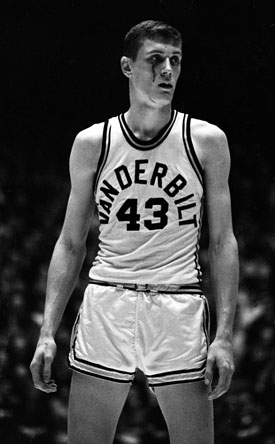 With two of the greatest individual performances in Vanderbilt history occurring on the same night, Vanderbilt defeated No. 3 Duke 97-92 in overtime on Dec. 11, 1963.
With two of the greatest individual performances in Vanderbilt history occurring on the same night, Vanderbilt defeated No. 3 Duke 97-92 in overtime on Dec. 11, 1963.
The Commodores got a career-high 39 points from John Ed Miller and Clyde Lee (pictured) snagged 26 rebounds and 21 points to lift the Commodores to victory. Miller’s point total was one short of a school record held by Jim Henry and Lee’s rebounding total tied the school record.
Miller also set whats was then a school record with 17 field goals and scored 10 of the team’s 12 points in overtime. The game appeared as if it was over in regulation when Miller buried a long jump shot, but Duke’s Jeff Mullins responded with a buzzer-beater to tie the game.
“We won and that’s the thing that is really important. I had some good games in high school, but there has never been anything like this.” John Ed Miller said.
Bob “Snake” Grace added 16 rebounds and combined with Lee to outrebound the entire Duke team in the first half as the Commodores led 48-35 at the break.
“Man, it’s so great I can’t stand it,” Vanderbilt Head Coach Roy Skinner said. “I was sitting over there on the bench with five fouls and almost had heart failure. The best ones are over Kentucky,” Skinner said. “But if this team had been No. 1 instead of two or three, it might be different.”
| 15) | Dec. 12, 1967 | MBB: Tom Hagan’s shot beats No. 8 Davidson |
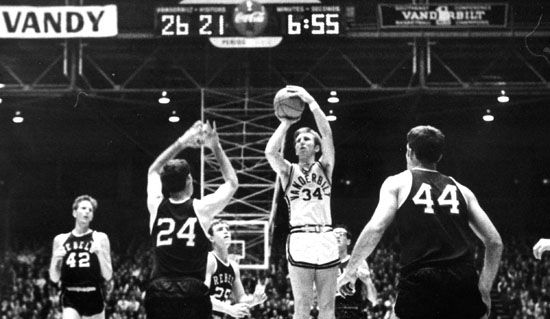
Vanderbilt defeated its second top 10 team in a span of four days when Tommy Hagan hit a 25-footer with two seconds remaining in overtime to lift Vanderbilt over No. 8 Davidson, 81-79, on Dec. 12, 1967.
The Commodores rallied from 13 points points down with five minutes to play to knock off Lefty Driesell’s Davidson team and improve to 4-0 on the season. Three days earlier, Vanderbilt defeated No. 5 North Carolina, 89-76.
Hagan (pictured) scored a team-high 21 points and had a chance to win the game in regulation, but his 15-footer fell off the rim as the horn sounded.
He would find redemption with his game-winner in overtime that brought fans rushing onto the court.
“I didn’t have time to think,” said Hagan of his final shot. “I had nothing on my mind except to try and spot somebody open in close. When I didn’t find anyone, I guess it was just instinct for me to shoot with the clock running out. I wasn’t thinking at all about the one I’d missed at the end of regular time.”
Davidson was in front for almost all of the game until a layup by Bob Warren tied it at 68 with less than six minutes to play. The win was Vanderbilt’s sixth consecutive overtime triumph over a two-year stretch.
“We played well enough to win, and we played our type of game,” Driesell said. “We wanted to run with Vanderbilt and we did. It all boiled down to the fact that Vanderbilt got the last shot and we didn’t I’d say everybody got their money’s worth.”
The 11,200 fans in attendance certainly did.
“They never quit battling. That’s why they won,” Vanderbilt Head Coach Skinner said.
The game was also very heated with Davidson’s Bill Wise being assessed with a technical foul for protesting a charging call. Driesell also drew warnings from officials and at one points Davidson’s trainer, Tom Crouch, and a fan had to be separated by a policeman.
Perry Wallace led VU with 10 rebounds in the win.
“Scared? You bet I was scared,” said Skinner of the team’s chances of winning. “I was scared before it started, scared while we were playing and scared, I guess, right up until Hagan hit that winner.
“I knew Davidson would be tough and I tried to impress this on the squad. It was almost like it was with us when North Carolina came in here Saturday night. They were rated No. 5 in the country and we were all wound up and ready to play. I knew Davidson would be looking down our throats when that No. 3 rating came out.”
| 16) | March 2, 1974 | MBB: Vanderbilt defeats Kentucky and clinches SEC title |
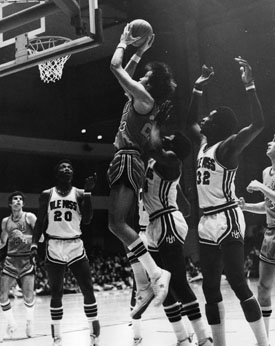 Vanderbilt wrapped up its first SEC title since 1965 when the Commodores topped Kentucky 71-69 on March 2, 1974. During the game, Vanderbilt had learned that Florida upset Alabama in Gainesville, meaning the win would claim at least a share of the SEC. Vanderbilt would have won the title outright over Alabama that year, but lost at Florida to close the regular season.
Vanderbilt wrapped up its first SEC title since 1965 when the Commodores topped Kentucky 71-69 on March 2, 1974. During the game, Vanderbilt had learned that Florida upset Alabama in Gainesville, meaning the win would claim at least a share of the SEC. Vanderbilt would have won the title outright over Alabama that year, but lost at Florida to close the regular season.
The Commodores defeated the Wildcats, but the game could have just as well gone to Kentucky. Vanderbilt trailed by 10 points on two occasions in the first half and the Wildcats had a shot at the buzzer to tie the game and send it to overtime. But Kentucky freshman Marion Haskins, who was playing in the first variety game of his career, missed a 10-foot jumper at the buzzer as the Commodores won.
“We had two points more than we needed .. and does it feel great to win,” Vanderbilt senior Terry Compton said.
Vanderbilt was led by Jeff Fosnes (pictured), who scored 24 points and Butch Feher, who scored 16 points in the last 20 minutes to finish with 18 for the game. Senior reserve Bill Ligon had six points and Lee Fowler scored eight.
The win gave Vanderbilt a 23-2 overall record and 15-2 SEC mark. The 23 wins were the second most in school history, bested only by the 1964-65 season when Vanderbilt had 24 wins. The Commodores would represent the SEC in the NCAA Tournament that season because it had defeated Alabama twice.
“I feel like a ton of pressure has been lifted from my shoulders,” Compton said. “It has been my dream since childhood when I used to shoot in my backyard up in Horse Cave (Ky.) to go to the NCAA Tournament. Now it has come true and it’s really hard to put into words how great it feels. We knew all along we were good enough to be champions. It’s very satisfying to prove it.”
To help get the Commodores back in the game, Head Coach Roy Skinner implemented the shuffle cut offense . Vanderbilt scored its final points on two foul shots by Fosnes with 41 seconds left. The announced attendance was 15,581.
| 17) | Feb. 24, 1983 | MBB: Phil Cox’s free throws beat Tennessee |
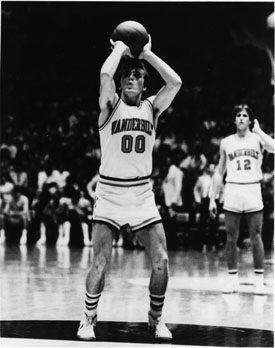 Vanderbilt defeated Tennessee, 69-68, on Feb. 24, 1983 on what is one of the most controversial calls in the history of Memorial Gym. With Vanderbilt trailing by one, Phil Cox drove the length of the floor, was fouled with one second to play on a blocking call against Tennessee’s Tyrone Beaman. As a result of the foul, Cox – the nation’s leading foul shooter – sank both free throws to beat the Vols. The controversial foul became known simply as “The Collision.”
Vanderbilt defeated Tennessee, 69-68, on Feb. 24, 1983 on what is one of the most controversial calls in the history of Memorial Gym. With Vanderbilt trailing by one, Phil Cox drove the length of the floor, was fouled with one second to play on a blocking call against Tennessee’s Tyrone Beaman. As a result of the foul, Cox – the nation’s leading foul shooter – sank both free throws to beat the Vols. The controversial foul became known simply as “The Collision.”
“I can’t say I wasn’t a little nervous, but I said to myself, `you have a chance to end it right here. I can make two or 50 free throws in a row. No reason I can’t get these,’ ” Cox said.
The Collision came after Dan Federmann hit a 15-footer to give Tennessee a 68-67 lead with five seconds left. As Cox (pictured) drove the lane and made contact with Beaman, official Allie Prescott called Beaman for a block as opposed to whistling Cox for charging.
“It was the worst call ever made on me in my life,” Beaman said. “I looked at the official and he looked at me. I said some things that he could have called a technical on me for, but he didn’t. He just looked at me as if to say he was sorry, but he had made the call and there was nothing he could do about it.”
The win snapped a three-game losing streak and moved Vanderbilt to 17-10 overall and 8-7 in the SEC. Earlier in the season, Vanderbilt had snapped a 10-game losing streak to No. Tennessee (17-8, 9-7 SEC) and with the win at Memorial Gym, the Commodores swept the season series for the first time since 1966. The win in Knoxville also came after two free throws by Cox with 12 seconds to play.
Cox, just a sophomore, finished with 22 points and Jeff Turner scored 17. Both teams shot better than 60% from the floor. Vanderbilt made 60.5% of its shots and Tennessee made 60.4% of its attempts. VU made 17-of-24 from the free-throw line and Tennessee made 4-of-6.
“It was another game in which an official determined the winner,” Tennessee Head Coach Don DeVoe said. “If you put Cox on the foul line at that point, the game is over.”
Tennessee had a costly turnover near the end of the game the kept the Commodores alive. With a one-point lead and the ball, Tennessee’s Dale Ellis made an inbounds pass that was deflected by Vanderbilt’s James Williams and wound up in the hands of Phil Cox. With 13 seconds left, Turner went to the line for a one-plus-one. He hit both and VU went in front before Tennessee regained the lead.
But what people will remember most from the game was the controversial call with one second on the clock.
“I realized that there was time to go all the way and I just went,” Cox said. “I did think about pulling up at the foul line for a jumper, but saw Federmann coming out. I just kept going and got lucky by being fouled. When I hit Beaman, I saw the referee signaling block. A lot of people are going to say I charged, but it’s not important now. It’s over and I’m glad the way I turned out.”
“I’m not saying it was a bad call, but there are too many games being decided by officiating decisions in this conference,” DeVoe said. “If I had it to do over again, I’d have Tyrone make exactly the same play he did.”
The game was played in front of 15,626 fans on the same day Vanderbilt Chancellor Joe B. Wyatt was inaugurated. With the win, it was the first time VU had beaten UT in football and twice in basketball in the same school year since 1954.
“They have beaten Tennessee twice in one season and it’s something they can remember and cherish the rest of their lives,” Vanderbilt Head Coach C.M. Newton said.
| 18) | Feb. 26, 1986 | MBB: VU sets NCAA record at free-throw line |
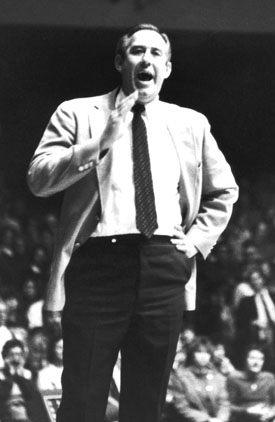 In one of the most impressive free-throw shooting performance in NCAA history, Vanderbilt sank a record 35-of-36 free throw attempts in a 77-65 win over Mississippi State on Feb. 26, 1986. The performance remains an NCAA record for percentage made with 35 attempts or more (97.2%).
In one of the most impressive free-throw shooting performance in NCAA history, Vanderbilt sank a record 35-of-36 free throw attempts in a 77-65 win over Mississippi State on Feb. 26, 1986. The performance remains an NCAA record for percentage made with 35 attempts or more (97.2%).
Vanderbilt made 29 straight free throws at one point and the lone miss came from reserve Randy Neff. Meanwhile Mississippi State made 9-of-12 free throws. Vanderbilt’s Brett Burrow tied a school single game record by making 12-of-12 free throws and finished with a game-high 20 points.
The odds finally caught up with us,” Burrow said. “We’re normally a good free throw shooting team, but we have had trouble lately. Tonight we were on. That’s the way you’re supposed to shoot `em.”
The win improved Vanderbilt to 13-10 overall and 7-10 in the SEC. Mississippi State dropped to 3-14 in the SEC, but one of those wins came at the hands of the Commodores earlier in the season.
“We played awfully well down the stretch and not just by hitting our free throws,” Head Coach C.M. Newton (pictured) said. “We beat a good basketball team tonight.”
Vanderbilt scored its last 18 points at the free-throw line and 20 of its last 22 to break open a 53-53 deadlock. The game was played in front of 12,787 fans.
| 19) | Jan. 14, 1989 | MBB: Goheen beats the buzzer twice |
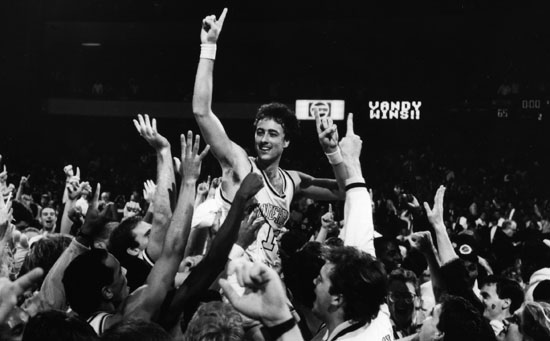
Barry Goheen had an open look at a two-pointer that would have tied the game and sent it to overtime, but instead he opted for a three-pointer that he splashed home to defeat Georgia 76-75 on Jan. 14, 1989. Goheen got the ball along the left baseline and took a few dribbled in before backing out for the winning three.
Amazingly, the buzzer-beater wasn’t even the first of the game for Goheen (pictured). He ended the first half by banking in a 53-footer.
“I can’t explain it; maybe a higher power takes over,” Goheen said.
“It’s downright spooky to see two shots like that in one game,” Vanderbilt Head Coach C.M. Newton said.
The second shot won the game and brought the crowd of 15,244 pouring onto the court chanting “Goheen! Goheen! Goheen!”
“I asked Barry (Goheen) if he knew what the score was,” Newton said. “I wanted to know if he knew we were only down two.”
“Did I know the score? Absolutely,” Goheen said. “But when I got the ball with five or six seconds left, I wasn’t going for a two-pointer, I decided I was going to work for the three and win it or lose it with one shot.
“I was wide open. I was surprised and a little off balance but I felt like I got a pretty good shot off.”
With Georgia leading 75-73 after two free throws by Goheen with 21 seconds left, the Bulldogs inbounded the ball and threw a long pass to Pat Hamilton, who was running open to the goal. At the last second, Vanderbilt’s Eric Reid made a quick lunge at the ball and distracted Hamilton who missed the layup. Georgia’s Marshall Wilson attempted to follow the miss with a dunk, but it hit off the back of the rim. Vanderbilt’s Barry Booker grabbed it and passed off to Goheen. As Booker passed the ball, he collided with a Georgia defender and both players fell to the floor, but the whistle did not blow.
Goheen would do the rest from there.
“I’m not aware of the crowd, the noise, the pressure or anything.” Goheen said. “I shoot, then I come out of a vacuum. I see the score, hear the crowd, then it sinks in.”
Vanderbilt improved to 9-7 overall and 4-1 in the SEC in what was Newton’s 499th career win. Goheen and Booker each finished with 16 points.
| 20) | March 14, 1990 | WBB: Five-second call aides VU in first NCAA Tournament game at Memorial |
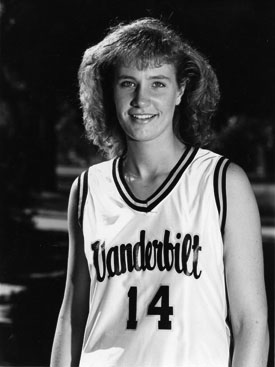 Vanderbilt was the beneficiary of a rare five-second call that helped the Commodores defeat Rutgers 78-75 in the first women’s basketball NCAA Tournament game at Memorial Gym on March 14, 1990.
Vanderbilt was the beneficiary of a rare five-second call that helped the Commodores defeat Rutgers 78-75 in the first women’s basketball NCAA Tournament game at Memorial Gym on March 14, 1990.
The win was Vanderbilt’s first in NCAA Tournament history after three previous times and helped pave the way for the first of eight straight Sweet 16 appearances.
Vanderbilt overcame a 12-point-point deficit in the last 3:25 to secure a win. Rutgers led 74-64 and had the ball out of bounds on Vanderbilt’s end of the court and called timeout. At the conclusion of the timeout, the horn sounded and Rutgers stayed in the huddle, saying later that they did not hear the horn. With Rutgers not breaking the huddle, the official placed the ball on the floor and began a five-second count.
As soon as Rutgers’ players realized what was taking place, they sprinted downcourt, but before they could make it, the referee had whistled for a five-second violation.
“That turnover took the wind out of our sails,” Rutgers Head Coach Thresa Grentz said. “That’s the first time I’ve ever seen it made. We never heard a buzzer or a whistle and no official ever came over to our huddle to warn us the timeout was over and he had started his count. If the benches had been at mid-court we could have made it.”
Vanderbilt took advantage of the costly turnover as Donna Harris sank a three-pointer to jump-start the comeback. Harris followed her three with a two-point bucket and then Rutgers turned the ball over on a player control foul. Vanderbilt’s Wendy Scholtens sank one free throw at the other end and Rutgers answered with a free throw to keep the Lady Knights ahead 75-70 with 1:09 to play.
However, Misty Lamb (pictured) then sank two free throws and Shelly Jarrard hit another for Vanderbilt after Rutgers turned the ball over. Jarrard missed the second free throw but gathered her own rebound and passed to Lamb, who made a 15-footer with 32 seconds left to give Vanderbilt a 76-75 lead. Rutgers then turned it over again and Lamb added two more free throws. The comeback was complete.
“It was a tough play for them,” Vanderbilt Head Coach Phil Lee said of the five-second violation. “That got us back in the game. And it got the crows into it, too. There’s no question in my mind if we had played this game in New Jersey we’d be coming home with a loss tonight.
“It is the biggest win in our program’s history.”
With a crowd of 3,500 in attendance, Vanderbilt improved to 22-10 overall and advanced to play at Iowa in the second round. Scholtens led Vanderbilt with 28 points.
“I never thought we could come back,” Scholtens said.
“I probably should have passed the ball,” Lamb said of her late buckets. “But the shots were there so I took them.”
| 21) | March 21, 1992 | WBB: Vanderbilt dominates UConn to advance to Sweet 16 |
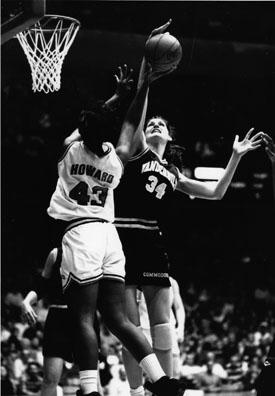 Under first-year Head Coach Jim Foster, Vanderbilt made sure Geno Auriemma’s UConn team would not be making a return trip to the Final Four by dominating the Huskies, 75-47, to advance to the Sweet 16 on March 21, 1992.
Under first-year Head Coach Jim Foster, Vanderbilt made sure Geno Auriemma’s UConn team would not be making a return trip to the Final Four by dominating the Huskies, 75-47, to advance to the Sweet 16 on March 21, 1992.
Vanderbilt scored the first eight points of the game and built a 32-14 lead with 4:03 to play in the first half. The game was never close from that point on.
“It was a great game for Vanderbilt,” Auriemma said. “If they continue to play like that, they’ll be hard to beat.”
“We were talking on the bench about already being in the Sweet 16,” senior guard Jade Huntington said. “Getting to the Sweet 16 was a definite goal for us. There was no set number of games we wanted to win to get there, but we want to go two steps beyond that. That’s our mindset.”
The Commodores out rebounded UConn 42-29 and were led by Heidi Gillingham (pictured) with 13 points and seven rebounds. Shelly Jarrard had 11 points, 10 rebounds and two steals. Misty Lamb also chipped in with 11 points and eight rebounds.
“We executed,” Foster said. “I don’t think we shot the ball that well but we executed. When you’re executing well you get a lot of offensive rebounds and second chances.”
Vanderbilt entered the game with extra motivation having lost in the SEC quarterfinals to Georgia, 58-57.
“I think we walked out of Albany (Georgia) convinced we had beaten ourselves, there was no excuses and it was time to step up,” Foster said. “The two weeks between that game and this one slowed us down, gave us poise and got our mindset right. This was a glimmer of light that this team is starting to understand what mental toughness means. “We’re starting to be tougher between he ears. Walking off the court at Albany, kicking ourselves in the butts and knowing we were responsible for losing that game ourselves got it started.”
“Vanderbilt had answers for just about everything on the court,” Auriemma said. “Their inside people did a great job of defense and their outside shooters were really on. We’re not a team that can traditionally come back. We didn’t shoot the ball well, and you don’t get many second chances against a team as big as Vanderbilt. This was the worst possible draw, because their strengths and our weaknesses went hand in hand. When you’re going to upset a team, you’ve got to get a lot of help from the other team and Vanderbilt didn’t give us any.”
It was the third straight Sweet 16 appearance for the Commodores, who were ranked No. 13 nationally and improved to 21-8 overall. UConn finished the season with a 23-11 record.
“Coach Foster told us we had all worked hard and given the effort physically,” Lamb said. “The rest was mental. That’s something that’s within ourselves and he couldn’t help us with it. It’s what’s inside us.”
“I could feel a real difference in myself and my attitude,” Gillingham said. “I was concentrating on the Heidi I can be.”
| 22) | Feb. 15, 2001 | WBB: McElhiney returns from injury and makes 14-of-14 free throws to beat LSU |
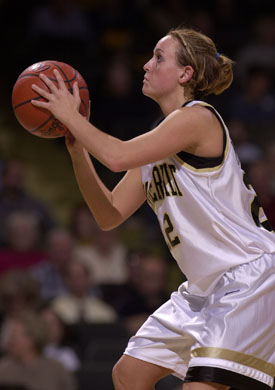 After missing three weeks from a stress fracture in her foot, Vanderbilt point guard Ashley McElhiney made her presence known in a big way against No. 13 LSU. McElhiney (pictured) scored a career-high 29 points, including the team’s final 17 to lead No. 20 Vanderbilt to an 86-75 win on Feb. 15, 2001.
After missing three weeks from a stress fracture in her foot, Vanderbilt point guard Ashley McElhiney made her presence known in a big way against No. 13 LSU. McElhiney (pictured) scored a career-high 29 points, including the team’s final 17 to lead No. 20 Vanderbilt to an 86-75 win on Feb. 15, 2001.
McElhiney did a lot of her damage at the free-throw line where she made 18-of-19 attempts, setting a school record for most attempts and tying the mark for most made. While scoring the team’s final 17 points, McElhiney was a perfect 14-for-14 from the free-throw line.
“They were not going to take the ball away from (McElhiney) at the end of the game,” Chantelle Anderson said. “You could see it in her eyes and you could hear it in her voice. It was obvious that she had the mindset that if they’re going to foul me, I’m going to punish them by making foul shots.”
McElhiney said after the game that even though she was hurt, she’d “been shooting in (her) boot.”
The game was tied at 56 points with 11:04 to play before Vanderbilt went on an 11-0 run. LSU never got closer than four the rest of the way. VU outscored LSU 26-10 at free-throw line and outrebounded, LSU 34-20.
Anderson scored 28 points as VU improved to 17-7 overall and 6-5 in the SEC. LSU fell to 17-7 overall and 7-4 in the SEC. Zuzi Kimesova had 14 points and 12 rebounds.
“That must have been some kind of miracle medicine for Ashley,” LSU Coach Sue Gunter said.
| 23) | Feb. 2, 2002 | WBB: Vanderbilt defeats No. 2 Tennessee |
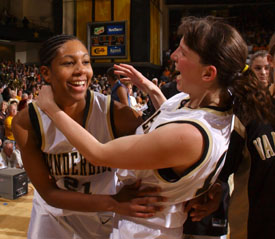 Vanderbilt overcame Chantelle Anderson’s first-half foul trouble to defeat No. 2 Tennessee, 76-59, on Feb. 2, 2002. Anderson, the team’s leading scorer at more than 20 points per game, played less than four minutes in the first half after picking up her second foul 3:38 into the game.
Vanderbilt overcame Chantelle Anderson’s first-half foul trouble to defeat No. 2 Tennessee, 76-59, on Feb. 2, 2002. Anderson, the team’s leading scorer at more than 20 points per game, played less than four minutes in the first half after picking up her second foul 3:38 into the game.
Despite Anderson’s absence, No. 8 Vanderbilt was able to overcome an 11-point first half deficit to tie the game at 29 heading into the locker room.
“We’ve gotten used to playing without Anderson over the course of time,” Vanderbilt Head Coach Jim Foster said. “We know how to play without her. We play a different way. The floor is bigger. We have more spacing, get a little feisty. She’s staying in games a lot more this year, but we have a frame of reference. It is one we’d like to put in the back of our minds.”
After weathering the storm without Anderson in the first half, Vanderbilt welcomed its All-American center back into the fold in the second half. Back in the game, Anderson was dominant. She scored a game-high 22 points, all in the second half. She played all 20 minutes in the half and hit 9-of-11 shots from the field.
“We went into the locker room and Coach (Jim) Foster said a couple of things to me,” Anderson said. “I just had to decide what kind of player I wanted to be. Did I want to be a player that my team could depend on in big games or did I want to be a player who they knew every time we had a big game I would not be there for them? I chose the first option.”
The game was tied at 29 before two free throws after intermission by Jillian Danker put VU up for good. Vanderbilt led by as many as 12 points and held off a late Tennessee run that pulled the Lady Vols within six, 65-59, with 1:47 to play.
“We came together. Bottom line, we played as a team. We didn’t play as five individuals,” junior Ashley McElhiney said. “When Chantelle, our big girl, goes out of the game, we have to come together even more. We focus so much of our offense around her, when she goes out of the game, we have to do some things differently. We kept our composure. We kept playing defense, rebounding and I think that is what triggered it.”
The win marked the first time Vanderbilt had defeated Tennessee in back-to-back games and was the first regular-season victory since the 1990-91 season.
“Vanderbilt was the better team for 40 minutes,” UT Coach Pat Summitt said. “We were better for 10 minutes but it’s a 40-minute game. Our front line can’t play the way it did and beat a team like Vanderbilt, playing the way it played, on the road – not rebounding the ball, not playing good defense.”
Jillian Danker finished with 19 points and 10 rebounds for the Commodores, which improved to 20-5 overall and 6-3 in the SEC. Tennessee dropped to 18-2 overall and 7-1 in the SEC.
“We’ve set a standard,” Danker said. “We know how we can play. We’re capable of beating any team. When we go out and lose now, we know we’re not playing up to the level we can play to.”
Despite having to exit the game early, a foul by Anderson set the tone of the game early. Tennessee’s Michelle Snow had dunked against Vanderbilt at Memorial Gym the previous year and had an open run at the basket before Anderson fouled her hard. “She wasn’t going to dunk it again,” Anderson said.
The play helped set the stage for the win that occurred in front of 14,168 fans in attendance.
“I love the atmosphere,” Danker said. “If you can’t be ready to play in this type environment, to play in a situation only a handful of people get to play in, you may not be breathing.”
| 23) | March 4, 2004 | MBB: Freije’s second half leads to comeback against Tennessee |
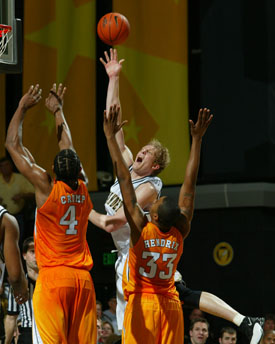 Matt Freije refused to allow his Senior Day to be ruined by Tennessee. In a game in which the Commodores trailed by 14 points, the senior forward put his teammates on his back by scoring 19 second-half points to lead Vanderbilt to a come-from-behind victory over Tennessee on March 4, 2004.
Matt Freije refused to allow his Senior Day to be ruined by Tennessee. In a game in which the Commodores trailed by 14 points, the senior forward put his teammates on his back by scoring 19 second-half points to lead Vanderbilt to a come-from-behind victory over Tennessee on March 4, 2004.
“I don’t think I’ve wanted a game down the stretch as much as I wanted that one,” Freije said. “Thank God we won it.”
The 61-58 victory gave Vanderbilt a winning record in SEC play and helped pave the way to an eventual Sweet 16 appearance.
With 13,455 in attendance, Freije (pictured) began to lead the comeback with Tennessee winning by 11 with 13:09 to play. A three-pointer by Freije with 1:57 to play gave Vanderbilt a 56-55 lead, its first since the opening minutes.
“I only wish we could have provided more excitement on Senior Night,” Vanderbilt Head Coach Kevin Stallings quipped.
“It was Senior Night, and we were playing Tennessee,”Freije said. “I could not imagine a better way to leave Memorial Gym. I could not imagine a better Senior Night.”
With the win, Vanderbilt set a school record for most home wins (15) in a season.
Tennessee’s Scooter McFadgon, the SECs top free-throw shooter at 92 percent, aided Vanderbilt’s comeback by missing the front end of two one-and-ones in the final five minutes.
“At times, you get winded and tired and you have to keep fighting through it,” Tennessee Head Coach Buzz Peterson said. “That’s what Freije did tonight. He got tired, but he hung in there. And with the experience he has, he knew he had to make winning plays, and he did.”Credit: Nashville Banner, Tennessean, Dynamite! 75 Years of Vanderbilt Basketball (Roy M. Neel), DVD: 50 Years of Memorial Magic

